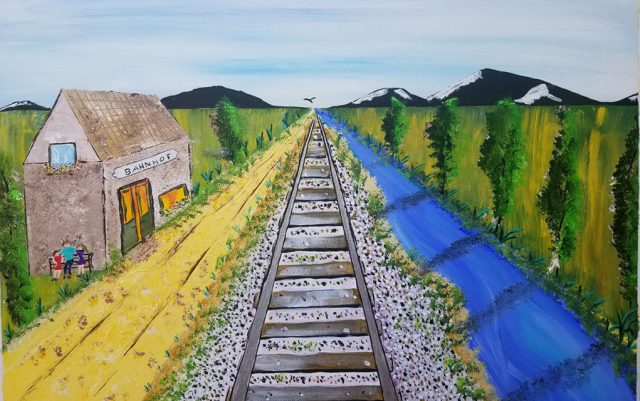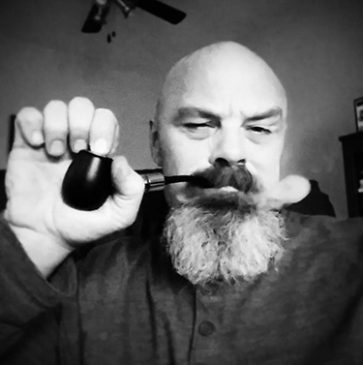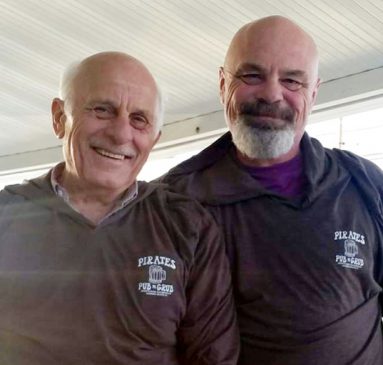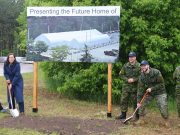
Nighttime. It was chaos: an organized chaos of hay trucks, tractors pulling carts, jalopies. Any motorized vehicle would suffice. They were staged and staggered for evacuation – knowledge of air raid sirens will do that. The Axis bombed the Allies and the Allies bombed the Axis. That is how it worked. There is no friend in purposeful death and destruction, just moral degradation. Morality in war. Sheesh!
Dietmar was six years old when his mother, Hedwig, piled him and his younger sisters, Inge at four years of age, and baby Gerlinda, aged two, onto the back of the hay truck. Priority was afforded to children and the broken-down defenceless, crammed shoulder to shoulder with just space enough to breathe. There were occasional shouts, muted sobs. Hands and arms reached through the slatted wooden boards for one last touch. With the diesel cough of an engine and the vibrating jolt of grinding into gear, slowly the truck began its blackout, potholed journey into the matte of inky black. And the distance between Hedwig’s and Dietmar’s touch grew. Hedwig, able-bodied and not broken, was denied passage on that truck. Dietmar cried. Hedwig wept. The girls knew nothing. Hedwig called out, “Wherever they take you, wait there. Look after your sisters, I will find you!”
The anesthetic of darkness and fear was interrupted only by the rolling thunder and flashes of evil only a ridgeline away.
Adolph, a common name for his time, was a corner-store owner who provided for Hedwig and their three children. His shelves relied on an unpredictable supply chain. Gradually, his small business could not survive with intermittent deliveries, and the tax of reparations. With his future uncertain and a family to care for, Adolph volunteered for military service under the populist leader who shared, coincidentally, the same first name.
Patriotic, fit, and proud, Adolph was deployed to the Eastern Front, about eight hundred kilometers south of Moscow, probably near the five-street village of Oktyabrskaya Gotnya. Adolph’s last known general whereabouts was in a bunker. No survivors. No remains. He is probably still there. According to history, he could be categorized as a fascist invader. According to Hedwig, Dietmar, and the girls, he was a soldier.

Prior to Adolph’s last deployment, he was home on leave and, in hushed tones with Hedwig, he conveyed that populism yielded to tyranny. The end was eventual. He urged Hedwig to “take the children, escape to the West!” Hedwig never saw Adolph again.
The spasmodic hay truck that carried Dietmar and the girls stopped at nautical dawn beside a Bahnhof (or train station). The Bahnhof was open to the elements. The single ceiling light hid the shadows and revealed pastel, cerulean-blue walls and pillars. As the three siblings got off the hay truck, the corner with wooden benches was the least breezy place, and that is where they waited. The din of people moving about existed, not with the rush of commuters, but the daze of the commuted. Morning turned to afternoon, evening, then night.
Baby Gerlinda cried. She was soiled, uncomfortable. They were all thirsty, hungry. Dietmar, remembering Hedwig’s instructions, knew to provide for his sisters. Throughout that Bahnhof and beyond, he scavenged and begged, and a stranger produced an orange. In that hungry isolated circumstance, someone did a moral right.
Dietmar returned to his sisters and peeled the orange with the greatest of care so as not to damage the rich flesh beneath. Done, he split the orange boats into thirds. He gave one third of the boats to Inge, and one third to Gerlinda. Then, he took his third and split it further, giving some to Gerlinda. When later asked, Dietmar explained why he split his third: “Gerlinda was the thirstiest.” It was that simple.
That night, they doze-slept on the benches in the corner, holding each other for warmth and comfort, waiting.
Throughout that day and night, Hedwig learned where her children were and found a way of her own to that Bahnhof. She found Dietmar, Inge and Gerlinda in that least breezy corner of the Bahnhof. She took them into her arms, never again letting go. Then they escaped to the West.
My “Orange” painting.
Dietmar was my father.
I do not know where the Bahnhof was. I do not know if it was large or small. I do not know if there were hills, trees, or a stream nearby. My “Orange” painting was created from a sketch tutorial about single point perspective, with the focal point being the horizon. I traversed that sketch to acrylic. On the left side of the painting is a bench with three children sitting on it, ostensibly waiting. On the bench and at the feet of where the children sit, there remains the peels of the orange.
My father passed away last year – assisted dying. My brother and I helped ease him out of this existence. I painted “Orange” with a heavy heart and the knowledge that if my father ever saw it, he would castigate me for structural and perhaps geographic inaccuracies. The story, however, remains the same.
He was a remarkable man.
Bio: Brian Lintner, born in Toronto, is the son of Irish and German immigrants. He is a veteran who served the Canadian Armed Forces for twenty-two years as a Military Policeman. He resides with his family in Burlington, Ontario, and has been a contributor to the Steel Spirit since 2017. To see more of Brian’s art visit www.zendenart.ca
The Steel Spirit is a platform for artwork submissions by Military, First Responder and Hospital Practitioners. They are always looking for new and emerging artists with and without experience, from every background and every age. For more information or if you would like to be involved, please visit: www.thesteelspirit.ca
By: Brian Lintner
Orange
De nuit. Le chaos. C’était un amoncellement organisé de camions à foin, de tracteurs tirant des charrettes, de vieux tacots. N’importe quel véhicule motorisé faisait l’affaire. Ils avaient été rangés et disposés en vue de l’évacuation, comme le laissaient présager les sirènes de raid aérien. L’Axe a bombardé les Alliés et les Alliés l’Axe. Il en va ainsi. La mort et la destruction intentionnelles ignorent l’amitié, le but est de saper le moral. La moralité de la guerre… pfff!
Dietmar avait six ans lorsque sa mère, Hedwig, l’a déposé à l’arrière du camion à foin avec ses sœurs plus jeunes, Inge, quatre ans, et la petite Gerlinda, âgée de deux ans. La priorité était accordée aux enfants et aux personnes vulnérables, entassés les uns contre les autres avec juste assez d’espace pour respirer. On entendait parfois des cris ou des sanglots étouffés. À travers les planches de bois, s’agitaient des mains et des bras pour un dernier adieu. Lentement, le camion commençait à s’ébranler et à plonger dans la nuit, laissant entendre le toussotement de son moteur diesel accompagné des secousses de son engrenage grippé. La distance qui séparait Hedwig et Dietmar ne cessait désormais de s’allonger. Hedwig, encore valide, encore en forme, n’avait pas été autorisée à monter sur ce camion. Dietmar pleurait. Hedwig sanglotait. Les filles l’ignoraient. Hedwig dit alors : « Où qu’ils vous emmènent, attendez là-bas. Occupe-toi de tes sœurs, je vous retrouverai! »

La torpeur suscitée par l’obscurité et la peur n’était interrompue que par le tonnerre roulant et les éclairs destructeurs visibles sur la ligne d’horizon.
Adolph, un prénom courant à cette époque, était le propriétaire d’une épicerie de quartier qui faisait vivre Hedwig et ses trois enfants. Les étagères de la boutique dépendaient d’une chaîne d’approvisionnement imprévisible. Peu à peu, en raison de l’intermittence des livraisons et des coûts des réparations à effectuer, la petite entreprise avait périclité. L’incertitude de l’avenir, et la nécessité de nourrir sa famille, avaient poussé Adolph à se porter volontaire pour le service militaire sous le règne du dirigeant populiste qui partageait, de manière fortuite, le même prénom que lui.
Patriotique, en bonne santé et fier, Adolph a été envoyé sur le Front de l’Est, à huit cents kilomètres environ au sud de Moscou, probablement près du village à cinq rues d’Oktyabrskaya Gotnya. Le dernier endroit où avait été aperçu Adolph était un bunker. Il n’y a eu aucun survivant. Plus aucune trace. Il est probablement encore là-bas. L’histoire raconte qu’il entrait dans la catégorie des envahisseurs fascistes. Selon Hedwig, Dietmar et les filles, il était un simple soldat.
Avant sa dernière mission, Adolph, revenu chez lui en permission, avait déclaré à voix basse à Hedwig que le populisme laissait place à la tyrannie. La fin fut fatale. Il suppliait Hedwig de « partir avec les enfants, fuir vers l’Ouest! » Hedwig n’a plus jamais revu Adolph.
Le camion à foin cahotant qui transportait Dietmar et les filles s’est arrêté au petit matin brumeux à côté d’un « Bahnhof » (une gare). La gare était exposée aux éléments naturels. Seul le plafonnier cachait les ombres et révélait des murs et des piliers couleur pastel, bleu céruléen. Lorsque les trois frères et sœurs sont descendus du camion à foin, ils se sont installés pour attendre dans un angle moins exposé au vent disposant de bancs en bois. Les allées et venues des gens occasionnaient un vrai vacarme; il ne s’agissait pas d’une heure de pointe, mais plutôt de la confusion qui régnait parmi les personnes qui déambulaient. Le matin laissa place à l’après-midi, puis au soir, et enfin à la nuit.
Gerlinda pleurait. Elle était souillée, inconfortable. Tous étaient assoiffés, affamés. Dietmar, se remémorant les instructions de sa mère Hedwig, savait subvenir aux besoins de ses sœurs. Il fouillait les poubelles de la gare et aux alentours, mendiait, et vint un moment où un étranger lui a donné une orange. Dans cette situation d’isolement et de faim, une personne avait réussi a fait preuve d’humanité.
Dietmar est alors revenu vers ses sœurs, puis a pelé l’orange avec le plus grand soin afin de ne pas endommager la chair si riche du dessous, puis a divisé l’orange en trois. Il a alors donné un tiers à Inge, un autre tiers à Gerlinda, puis a redécoupé son tiers, pour en donner davantage à Gerlinda. Plus tard, Dietmar confiera qu’il avait divisé sa part parce que « Gerlinda était la plus assoiffée ». C’était tout.
Cette nuit-là, ils avaient somnolé sur les bancs dans le coin, se tenant les uns contre les autres afin de se tenir au chaud et être plus confortables, en attendant.
Une journée et une nuit s’étaient écoulées quand Hedwig apprit où se trouvaient ses enfants, et elle avait su atteindre la gare par ses propres moyens. Sur place, elle découvrit Dietmar, Inge et Gerlinda dans le coin de la gare le plus abrité du vent. Elle les a pris dans ses bras, pour ne plus jamais les quitter. Puis ils se sont tous échappés vers l’Ouest.
Mon tableau « Orange »
Dietmar était mon père.
Je ne sais pas où cette gare était située. Je ne sais pas si elle était grande ou petite. Je ne sais pas s’il y avait des collines, des arbres ou un ruisseau à proximité. J’ai peint mon tableau intitulé « Orange » après avoir suivi un tutoriel de croquis sur la perspective à un seul point de fuite, le point focal étant l’horizon. J’ai réalisé ce croquis à l’acrylique. Du côté gauche du tableau se trouve un banc, avec trois enfants assis dessus qui attendent, apparemment. Sur le banc et au pied des enfants, il reste les écorces de l’orange.
Mon père est décédé l’an dernier (aide médicale à mourir). Mon frère et moi l’avons aidé à le sortir de cette existence. J’ai peint « Orange » avec un cœur lourd, et je suis convaincu que si mon père pouvait le voir, il m’en voudrait sûrement à cause des inexactitudes du lieu et, peut-être, géographiques. Toutefois, l’histoire demeure la même.
C’était un homme remarquable.
Notice biographique : Brian Lintner, né à Toronto, est fils d’immigrants irlandais et allemands. Ancien combattant, il a servi les Forces armées canadiennes pendant vingt-deux ans en tant que policier militaire. Il habite avec sa famille à Burlington, en Ontario, et apporte sa contribution à Steel Spirit depuis 2017. Pour en savoir plus sur l’art de Brian, rendez-vous sur la page www.zendenart.ca.
Steel Spirit est une plateforme dédiée à la présentation d’œuvres d’art de militaires, premiers intervenants et professionnels des hôpitaux. Elle recherche en permanence de nouveaux artistes et des artistes émergents, avec ou sans expérience, indépendamment de l’origine et de l’âge. Pour obtenir plus d’informations ou vous impliquer dans ce projet, n’hésitez pas à consulter le site www.thesteelspirit.ca.
Par : Brian Lintner










